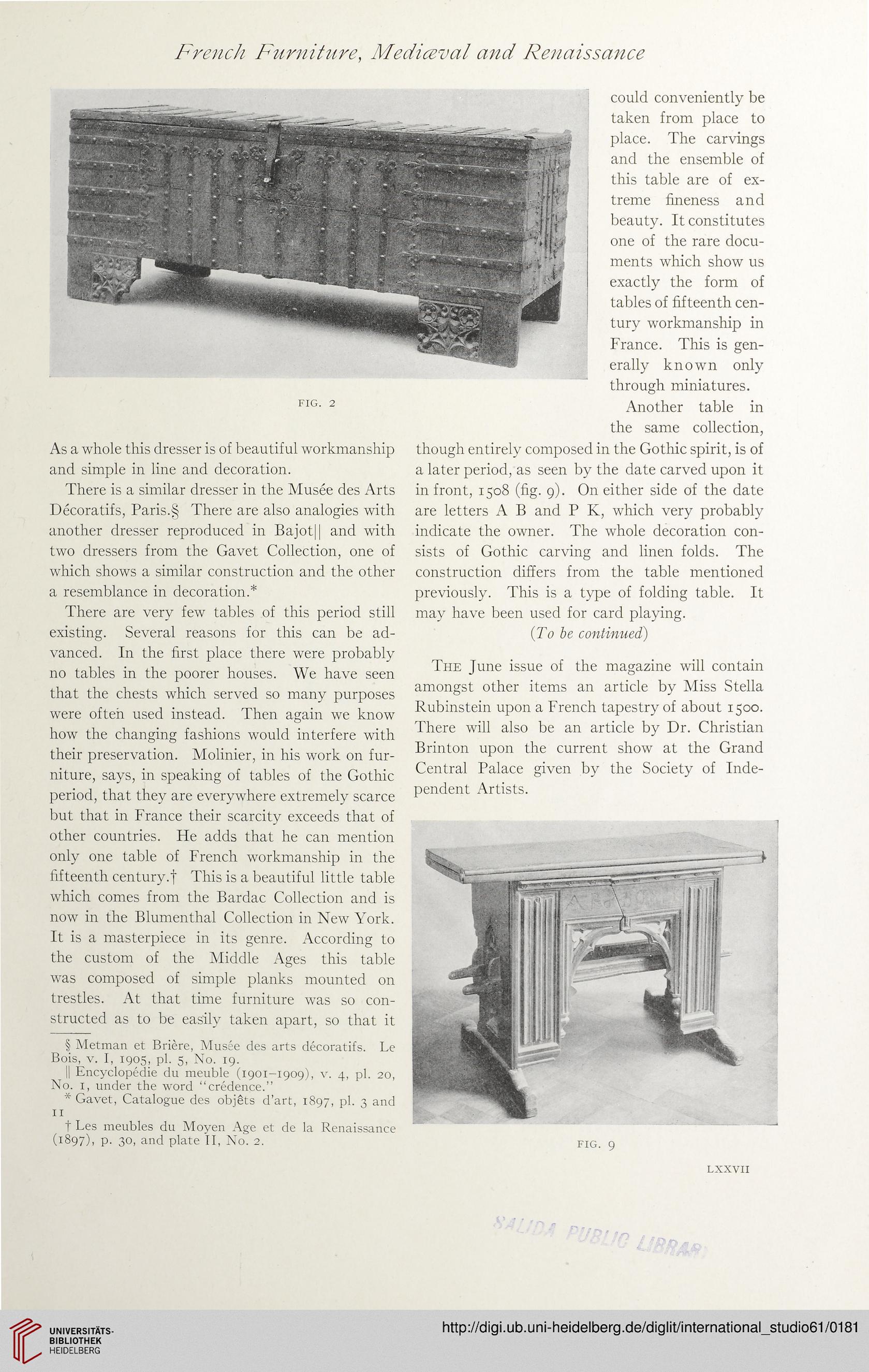French Furniture, Mediceval and Renaissance
FIG. 2
As a whole this dresser is of beautiful workmanship
and simple in line and decoration.
There is a similar dresser in the Musee des Arts
Decoratifs, Paris.§ There are also analogies with
another dresser reproduced in Bajot|| and with
two dressers from the Gavet Collection, one of
which shows a similar construction and the other
a resemblance in decoration.*
There are very few tables of this period still
existing. Several reasons for this can be ad-
vanced. In the first place there were probably
no tables in the poorer houses. We have seen
that the chests which served so many purposes
were often used instead. Then again we know
how the changing fashions would interfere with
their preservation. Molinier, in his work on fur-
niture, says, in speaking of tables of the Gothic
period, that they are everywhere extremely scarce
but that in France their scarcity exceeds that of
other countries. He adds that he can mention
only one table of French workmanship in the
fifteenth century.f This is a beautiful little table
which comes from the Bardac Collection and is
now in the Blumenthal Collection in New York.
It is a masterpiece in its genre. According to
the custom of the Middle Ages this table
was composed of simple planks mounted on
trestles. At that time furniture was so con-
structed as to be easily taken apart, so that it
§ Metman et Briere, Musee des arts decoratifs. Le
Bois, v. I, 1905, pl. 5, No. 19.
|| Encyclopedic du meuble (1901-1909), v. 4, pl. 20,
No. 1, under the word “credence.”
* Gavet, Catalogue des obj^ts d’art, 1897, pl. 3 and
11
t Les meubles du Moyen Age et de la Renaissance
(1897), p. 30, and plate II, No. 2.
could conveniently be
taken from place to
place. The carvings
and the ensemble of
this table are of ex-
treme fineness and
beauty. It constitutes
one of the rare docu-
ments which show us
exactly the form of
tables of fifteenth cen-
tury workmanship in
France. This is gen-
erally known only
through miniatures.
Another table in
the same collection,
though entirely composed in the Gothic spirit, is of
a later period, as seen by the date carved upon it
in front, 1508 (fig. 9). On either side of the date
are letters A B and P K, which very probably
indicate the owner. The whole decoration con-
sists of Gothic carving and linen folds. The
construction differs from the table mentioned
previously. This is a type of folding table. It
may have been used for card playing.
(To be continued}
The June issue of the magazine will contain
amongst other items an article by Miss Stella
Rubinstein upon a French tapestry of about 1500.
There will also be an article by Dr. Christian
Brinton upon the current show at the Grand
Central Palace given by the Society of Inde-
pendent Artists.
fig. 9
lxxvii
FIG. 2
As a whole this dresser is of beautiful workmanship
and simple in line and decoration.
There is a similar dresser in the Musee des Arts
Decoratifs, Paris.§ There are also analogies with
another dresser reproduced in Bajot|| and with
two dressers from the Gavet Collection, one of
which shows a similar construction and the other
a resemblance in decoration.*
There are very few tables of this period still
existing. Several reasons for this can be ad-
vanced. In the first place there were probably
no tables in the poorer houses. We have seen
that the chests which served so many purposes
were often used instead. Then again we know
how the changing fashions would interfere with
their preservation. Molinier, in his work on fur-
niture, says, in speaking of tables of the Gothic
period, that they are everywhere extremely scarce
but that in France their scarcity exceeds that of
other countries. He adds that he can mention
only one table of French workmanship in the
fifteenth century.f This is a beautiful little table
which comes from the Bardac Collection and is
now in the Blumenthal Collection in New York.
It is a masterpiece in its genre. According to
the custom of the Middle Ages this table
was composed of simple planks mounted on
trestles. At that time furniture was so con-
structed as to be easily taken apart, so that it
§ Metman et Briere, Musee des arts decoratifs. Le
Bois, v. I, 1905, pl. 5, No. 19.
|| Encyclopedic du meuble (1901-1909), v. 4, pl. 20,
No. 1, under the word “credence.”
* Gavet, Catalogue des obj^ts d’art, 1897, pl. 3 and
11
t Les meubles du Moyen Age et de la Renaissance
(1897), p. 30, and plate II, No. 2.
could conveniently be
taken from place to
place. The carvings
and the ensemble of
this table are of ex-
treme fineness and
beauty. It constitutes
one of the rare docu-
ments which show us
exactly the form of
tables of fifteenth cen-
tury workmanship in
France. This is gen-
erally known only
through miniatures.
Another table in
the same collection,
though entirely composed in the Gothic spirit, is of
a later period, as seen by the date carved upon it
in front, 1508 (fig. 9). On either side of the date
are letters A B and P K, which very probably
indicate the owner. The whole decoration con-
sists of Gothic carving and linen folds. The
construction differs from the table mentioned
previously. This is a type of folding table. It
may have been used for card playing.
(To be continued}
The June issue of the magazine will contain
amongst other items an article by Miss Stella
Rubinstein upon a French tapestry of about 1500.
There will also be an article by Dr. Christian
Brinton upon the current show at the Grand
Central Palace given by the Society of Inde-
pendent Artists.
fig. 9
lxxvii




